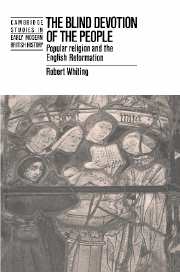Book contents
- Frontmatter
- Contents
- List of illustrations
- Preface
- Note
- 1 Introduction
- 2 Survey
- PART ONE ASSESSMENT
- 3 Dependent activities: sacraments, ceremonies and intercessions
- 4 Independent activities: prayers, images and cult objects
- 5 Inclusive institutions: parish churches, chapels and guilds
- 6 Exclusive institutions: papacy, religious orders and secular clergy
- 7 Summation of Part One
- PART TWO EXPLANATION
- Appendix 1 Maps
- Appendix 2 Graphs
- Bibliography and abbreviations
- Index
5 - Inclusive institutions: parish churches, chapels and guilds
Published online by Cambridge University Press: 11 December 2009
- Frontmatter
- Contents
- List of illustrations
- Preface
- Note
- 1 Introduction
- 2 Survey
- PART ONE ASSESSMENT
- 3 Dependent activities: sacraments, ceremonies and intercessions
- 4 Independent activities: prayers, images and cult objects
- 5 Inclusive institutions: parish churches, chapels and guilds
- 6 Exclusive institutions: papacy, religious orders and secular clergy
- 7 Summation of Part One
- PART TWO EXPLANATION
- Appendix 1 Maps
- Appendix 2 Graphs
- Bibliography and abbreviations
- Index
Summary
Of those Catholic institutions in which the layman was permitted to participate, the most important on the eve of the Reformation were unquestionably the church and chapels of his parochial community.
The parish often maintained chapels and always a church. If the layman dwelled at a distance from his church, he would usually attend services in a parochial chapel; an example remains at Bulkworthy in the parish of Buckland Brewer. If attached to the household of a gentleman or substantial yeoman, he might worship in a private chapel of the type still visible near Lapford at Bury Barton. It was nevertheless the church that accommodated most of the important religious activities of the parochial community. Usually this was located close to the centre of its town or village, though not infrequently it was surrounded only by a hamlet and sometimes it stood at some distance from its maintaining settlement. It undoubtedly performed a number of essentially secular functions, but its primary purpose was always the provision of an architectural environment suitable for the activities of traditional Catholicism.
The typical church of the pre-Reformation South-West was approximately rectangular in plan. Its walls were of local stone and its roofs of timber, generally of wagon-type with bosses at the intersections, though stone vaulting might cover a porch or aisle. Its most spacious component, the nave, housed the parishioners themselves; here, during services, they stood, knelt or sat.
- Type
- Chapter
- Information
- The Blind Devotion of the PeoplePopular Religion and the English Reformation, pp. 83 - 112Publisher: Cambridge University PressPrint publication year: 1989
- 1
- Cited by



